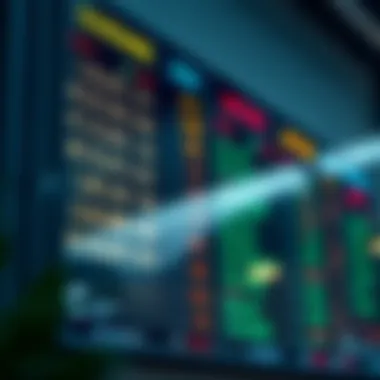Conversion Insights: 120,000 AED to USD


Intro
Understanding the nuances of currency conversion is crucial, especially when considering investments and financial transactions across borders. One such pertinent example is the conversion of 120,000 United Arab Emirates Dirhams (AED) into United States Dollars (USD). The exchange rate between these two currencies can have a significant impact on purchasing power, investment strategies, and overall financial planning for individuals and businesses alike.
The upcoming sections will provide insight into the factors that affect these exchange rates, such as economic indicators, geopolitical events, and shifts in market sentiment. Furthermore, we will explore how these conversions relate specifically to the rapidly evolving real estate market in Dubai, a hub for investors and expatriates alike. \n In this article, we will take a close look at:
- Current trends within the Dubai real estate market
- Property types and their comparative significance
- High-growth areas for potential investment
- Calculating rental yields and return on investment (ROI)
Let’s embark on this journey to demystify the conversion of AED to USD and its implications for anyone contemplating financial activities in this dynamic marketplace.
Foreword to Currency Conversion
Currency conversion is a vital aspect of global commerce, particularly for those engaged in international transactions, such as investors and expatriates. The interplay between different currencies drives the economy, influencing purchasing decisions and investment strategies. This article will take a closer look at the conversion of 120,000 AED to USD, offering insights into various factors that can impact this exchange.
Understanding Currency Exchange
At its core, currency exchange is the process of converting one country's currency into another. The value of each currency fluctuates regularly due to a multitude of factors including economic indicators, geopolitical stability, and market sentiment.
Understanding the mechanics of how these currencies relate can empower individuals and businesses to make informed decisions. For example, if the AED is strong against the USD, it means that fewer dirhams are needed to acquire dollars, affecting spending power abroad. This is particularly important for expatriates living in the UAE who might be planning to send funds home or purchase assets in other countries. Moreover, investors analyzing market trends need to grasp these conversions to optimize their investment strategies.
Market players often utilize various tools like real-time exchange rate platforms to track fluctuations. Familiarity with these processes can aid in predicting potential gains or losses when moving money across borders.
Importance of Accurate Conversion
Accurate currency conversion is not merely a technical detail; it is the backbone of effective financial planning for individuals and businesses. An imprecise rate can lead to significant differences in the amount received. To illustrate, if one were to convert 120,000 AED to USD, even a small differential in the exchange rate could impact the final conversion amount considerably.
"Precision in currency conversion can mean the difference between an opportunity seized and an opportunity missed."
Additionally, tenured investors often keep an eye on both current and historical exchange rates to make informed predictions about future trends. This consideration can be the deciding factor in whether to buy or sell an asset in the international market.
Ultimately, the importance of correct conversion extends to budgeting and overall financial health, particularly for those engaged in international transactions. An astute understanding of currency conversion can empower expatriates and investors alike, allowing them to navigate the intricacies of the financial world with greater confidence.
Current Exchange Rate: AED to USD
Understanding the current exchange rate between the United Arab Emirates Dirham (AED) and the United States Dollar (USD) is pivotal for anyone involved in international finance, investment strategies, or even for expatriates living in the UAE. This section will delve into why these rates matter, not merely as numbers on a screen, but as critical indicators that reflect economic health, trade balances, and market sentiment.
The exchange rate can make or break a deal, affecting purchasing power significantly. For instance, a favorable rate might mean the difference between securing a property in Dubai's flourishing real estate market or being priced out of a deal. Therefore, keeping tabs on current rates is not just good business—it's essential.
Real-Time Exchange Rates
Real-time exchange rates offer a snapshot of the AED’s current value against the USD. These rates fluctuate constantly due to various factors like market demand, economic indicators, political events, and more. Investing in real estate or making large purchases without understanding the real-time rate can be a risky endeavor.
Various platforms and financial institutions provide real-time data. For example, websites like xe.com and OANDA ensure investors have up-to-the-minute information on currency values.
- Key Benefits of Real-Time Rates:


- Informed Decision-Making: Gain insights needed for negotiating prices in real estate.
- Hedge against Fluctuations: Investors can optimize their buying or selling times based on the day's exchange rate.
- Effective Financial Planning: Helps expatriates in budgeting for international remittances or expenses.
Historical Exchange Rate Trends
Looking at historical trends can provide context to current exchange rates. For example, knowing how the AED has historically valued against the USD can help predict future movements. Trends can be analyzed over various time frames—months, years, or even decades.
Expats and investors alike should take notes from historical highs and lows. If the AED was significantly weaker against the USD a year ago, it might indicate favorable conditions for investment now, especially given the potential for appreciation.
- Factors Influencing Historical Trends:
- Economic Events: Financial crises, wars, or large-scale investments can alter the landscape dramatically.
- Policy Changes: Changes in government policies, trade agreements, or monetary policy by central banks can influence currency strength.
- Global Market Conditions: Economic health in major countries can spill over and affect smaller economies, including the UAE.
"Understanding the historical context allows for a more nuanced approach in predicting future fluctuations in exchange rates, which can very well influence investment decisions."
In summary, the current exchange rate between AED and USD serves as a crucial barometer for investors, expatriates, and anyone else navigating international financial waters. Having real-time data and an understanding of historical trends enables more informed decision-making, ensuring that investments in the UAE market are calculated and strategic.
Calculating , AED in USD
Understanding how to convert 120,000 AED to USD is not just about numbers. It’s about acquiring insight into market dynamics, purchasing power, and investment potential. The conversion provides a practical vantage point for anyone looking to engage in transactions across borders, especially in real estate. Whether you’re an investor eyeing up properties in Dubai or an expatriate sending money back home, knowing the conversion helps you make savvy financial decisions.
Step-by-Step Conversion Process
First off, let’s break things down into manageable steps to make this conversion straightforward.
- Check the Current Exchange Rate: Before doing any calculations, find the real-time exchange rate. This number fluctuates frequently, so using a reliable source, such as a financial website like XE.com or OANDA, is recommended.
- Perform the Conversion Calculation: Once you have the exchange rate, multiply the amount in AED by the exchange rate to get the equivalent in USD. For instance, if the exchange rate is 0.27, the math would look like this:120,000 AED * 0.27 = 32,400 USD
- Consider Additional Fees: Keep in mind that banks or exchange services might charge fees. These can take a bite out of your final amount, so it's wise to factor in these costs.
- Verify the Conversion: It’s good practice to check your calculation using an online currency converter. This acts as a safety net to confirm your math is correct.
The process might look simple, but precision is crucial. A slight hiccup in figuring out the exchange rate or calculating fees can lead to misjudged financial outcomes.
Factors That Influence Conversion Amount
Several elements can sway the conversion amount from AED to USD:
- Economic Conditions: Changes in economic performance or stability in either the UAE or the U.S. can influence exchange rates. Strong economic growth might strengthen the AED against the USD.
- Inflation Rates: Inflation can impact the purchasing power of a currency. If inflation in the UAE rises without a similar increase in the U.S., the AED may depreciate against the USD.
- Political Events: Geopolitical tensions or advantageous trade agreements can shift investor confidence, affecting currency exchange rates.
- Market Sentiment: Perceptions of future economic performance can influence currency values. If investors believe that the UAE is an attractive place for investment, they may favor the AED, affecting its strength against the USD.
- Interest Rates: Higher interest rates in the U.S. could attract foreign capital, resulting in a stronger USD relative to the AED.
Understanding these factors is essential for anyone looking to deal in currency exchanges. Being aware of the broader economic landscape helps in anticipating potential shifts in the exchange rates and planned financial actions.
“In the world of currency exchange, knowledge is not just power; it’s also profitable.”
By keeping these points in mind, you'll be better equipped to navigate the waters of currency conversion, ensuring that you don’t end up with a surprise at the end of the day.
Impact of Exchange Rates on Real Estate
Understanding how exchange rates impact real estate is crucial not just for investors, but also for individuals looking to buy property in a foreign market. With the conversion of currencies being a significant aspect of international real estate deals, fluctuations in exchange rates can influence purchasing power and overall investment viability.
Real estate, especially in vibrant markets like Dubai, plays a delicate balancing act with currency conversion rates. When the UAE Dirham strengthens against the US Dollar, this means that those using USD to invest may find themselves shelling out more to secure properties, thereby changing the dynamics of the market.


Effects on Property Prices
The influence of exchange rates on property prices is multifaceted. As exchange rates fluctuate, property prices can react accordingly. Generally, when the Dirham appreciates, foreign currency holders may find that their USD can fetch less in the real estate market.
- Price Increase for Foreign Investors: If the Dirham is strong, a buyer from the United States may see a hike in the nominal prices of properties listed in AED. This puts foreign investors at a potential disadvantage unless they can readjust their expectations or budget.
- Domestic Price Stability: Conversely, for local buyers, a strong Dirham may stabilize the market, easing the burden on domestic purchasers.
- Market Dynamics: The overall demand in the market will shift as a response. Should foreign buyers feel priced out due to a stronger Dirham, the supply may exceed the demand, leading to price corrections in the long term.
In essence, the property market can be seen as a chess game, where each move by exchange rates alters the board, affecting both local investors and expatriates alike. This dynamic interplay requires close observation by all parties involved.
Investor Perspective on Currency Fluctuations
For investors, not keeping a keen eye on currency fluctuations may lead to missed opportunities or unforeseen losses. Here are a few considerations:
- Risk Assessment: Investors should analyze potential risks tied to currency movements. A sudden downturn in the Dirham’s value could significantly reduce the actual returns when profits are repatriated to the investor’s home country.
- Strategic Timing: Timing can play a decisive role in entering the market. An investor attuned to market trends may choose to make a purchase during favorable exchange rates, thereby maximizing their investment potential.
- Diversification of Currency: Many seasoned investors advocate for a diversified currency portfolio. This strategy mitigates risk, as it allows for a smoother navigation through fluctuating global rates.
The savvy investor knows that the only constant in forex is change; a wise strategy is to always be prepared to adapt.
In summary, the connection between exchange rates and real estate is undeniably intricate. With the potential for significant fluctuations impacting both investors and buyers, navigating this landscape demands informed decision-making and strategic foresight.
Practical Implications for Buyers and Investors
Understanding the practical implications of converting AED to USD is crucial for anyone looking to navigate the Dubai real estate market. With the Emirati market being a hub for potential growth, having a solid grasp of currency conversion not only aids in budgeting but also influences investment decisions. For buyers and investors, the ability to determine the purchasing power and financial strategy based on exchange rates can lead to a trajectory of smarter investments.
Buying Power in the Dubai Market
Buying power in the Dubai market is a reflection of how much your currency can get you in terms of property and investments. When converting 120,000 AED to USD, you need to pinpoint the exchange rate at the time of the conversion to know how many US dollars your AED translates into. For instance, if the current rate stands at 1 AED = 0.27 USD, your 120,000 AED would equate to 32,400 USD.
- Market Participation: A lower exchange rate might make it cheaper for expatriates and foreign investors to buy property, boosting participation in the market from abroad. This can create more competition and a rise in property prices if demand surges.
- Comparative Analysis: Understanding how your purchasing power translates into the local market allows buyers to compare properties more effectively. It positions you better to weigh options in various neighborhoods without underestimating costs or potential returns.
- Cost Behavior: Fluctuations in the exchange rate can also affect the cost of living, which is significant for expatriates. When the USD becomes stronger relative to the AED, everyday expenses could seem higher for those earning in AED but planning expenses in USD.
"In the Dubai market, your buying power can shift like the desert wind; a little understanding goes a long way in making sound investments."
Real Estate Investment Strategy
Creating a robust real estate investment strategy is central for both local and expatriate investors in Dubai. Once you comprehend your buying power, the next step involves developing a strategic approach that aligns with the currency fluctuations.
- Long-Term vs Short-Term: Define whether your goal is long-term capital appreciation or short-term gains. Investors eyeing long-term holds may overlook short-term currency swings.
- Diversification: Think about diversifying your investments across different properties or even geographical locations within the UAE. By doing so, you might balance the risks associated with currency shifts and market volatility.
- Leverage Opportunities: During favorable exchange rates, investors can leverage their AED to acquire more valuable properties or larger assets than they could in a fluctuating market.
- Regular Review: Continuous monitoring of the exchange rates and adapting your strategy accordingly will give you a competitive edge. Planned reviews of both your investment and the market conditions could lead to optimal selling or buying moments.
By staying informed and adjusting strategies, investors can turn potential challenges from currency fluctuations into lucrative opportunities.
To further enhance your understanding of the market, consider checking resources like Investopedia and Zillow for updated market insights.
Converting AED to USD for Expatriates
Converting AED to USD holds significant relevance for expatriates, especially those living and working in the UAE. The expatriate community in the UAE is diverse and dynamic, comprising individuals from all walks of life. As expatriates often earn their salaries in AED, understanding how to convert this amount to USD is vital for various reasons, including budgeting, investing, and sending money back home.
Financial Planning for Expatriates


For expatriates, financial planning is key to maintaining and enhancing their purchasing power. When converting AED to USD, there are a few aspects one should consider:
- Living Costs: Expatriates often face higher living costs depending on their country of origin. Understanding the exchange rate allows them to gauge how much their earnings in AED will translate in USD. This translates to better budgeting for everyday expenses and savings.
- Investment Opportunities: Many expatriates look at investment prospects back home or in other countries. Knowing the current conversion rate is critical to ensure that they make informed decisions. For example, an expatriate planning to invest $50,000 in real estate in the US should grasp how many AED they need to gather for that investment.
- Future Planning: With fluctuating exchange rates, it’s wise to keep an eye on trends. Expatriates planning for long-term financial goals, such as retirement or education for children, can benefit from forecasting exchange rate movements. This way, they can time their conversions for greater efficiency.
Practical Considerations for Transfers
When it comes to transferring funds from AED to USD, expatriates face a host of practical considerations:
- Fees and Costs: Different banks and money transfer services charge various fees for currency conversion. It is essential for expatriates to shop around and find the service that offers the best rates with the least fees. Some services may seem appealing initially, but hidden charges can bite into the total amount transferred.
- Timing of Transfers: Exchange rates can fluctuate considerably within a short time. Expatriates should monitor the market closely or use tools that alert them about favorable rates. In some cases, setting a limit order can secure an exchange rate that is more favorable.
- Regulatory Considerations: Depending on their home country, expatriates may face different regulations regarding international money transfers. It’s wise to understand these rules to avoid complications or delays in transferring funds.
As the saying goes, "money makes the world go round," so staying informed about currency conversions and exchange rates can empower expatriates to make savvy financial choices.
Future Trends in Currency Exchange
The dynamics of currency exchange are always evolving, putting a strong emphasis on the importance of understanding future trends. This section provides insights into how the fluctuating exchange rates between the United Arab Emirates Dirham (AED) and the United States Dollar (USD) can affect both personal finances and investment strategies. Staying abreast of these trends allows investors, agents, developers, analysts, and expatriates to make informed decisions regarding conversions and purchasing power in the Dubai real estate market.
One must consider the interplay between economic indicators, political events, and market sentiments when forecasting currency trends. As the world becomes increasingly interconnected, the ramifications of global economic changes may trickle down to local levels, making it essential for stakeholders to be aware of potential shifts.
Forecasting AED vs. USD Trends
Predicting future movements in the AED/USD exchange rate is akin to reading the tea leaves; it can be an uncertain but crucial endeavor. Several key factors shape these forecasts:
- Interest Rates: Central banks, like the UAE Central Bank and the Federal Reserve, play a significant role in currency valuation. An increase in interest rates typically attracts more foreign investment, boosting the demand for that currency.
- Economic Indicators: Monitoring data such as GDP growth, unemployment rates, and inflation numbers provide a snapshot of economic health. Strong performance in these areas generally supports a stronger currency.
- Political Stability and Policies: The political landscape in the UAE and the US influences investor confidence. Political unrest, changes in governance, or significant policy shifts can lead to volatility in exchange rates.
- Market Sentiment: This involves the collective mood of investors which may change based on news events, social media trends, or global economic data. Such sentiment can lead to rapid changes in currency valuations.
As trends emerge, stakeholders can utilize various tools for forecasting, including economic reports or analytical software, to gain deeper insights into expected movements in the AED/USD conversion.
Potential Economic Influences
Understanding the economic factors that could influence future exchange rates is paramount. These influences can stem from both global and regional contexts:
- Global Economic Environment: Events such as recessions or booms in major economies can affect the demand for currencies. A slowdown in a major economy like the US could lead to a weaker USD, impacting the exchange rate with the AED.
- Oil Prices: Given that the UAE is a significant oil producer, fluctuations in oil prices directly affect its economy and, by extension, the strength of the AED. Increased oil prices generally enhance the national income, which can support a robust AED.
- Regulatory Changes: Financial regulations, both locally and at the international level, can profoundly influence currency exchange. Stricter regulations might impede currency converts, while favorable policies can enhance the flow of investments.
- Technological Innovations: Adoption of advanced financial technologies, like blockchain and AI in currency exchange systems, could shift the paradigms of trading and valuation. The rise of digital currencies may also have unforeseen effects on traditional currencies.
It's crucial for individuals and businesses operating in the marketplace to continuously analyze these factors while adapting their strategies accordingly. Keeping a finger on the pulse of the economy can offer a strategic edge in anticipating exchange rate movements and optimizing financial decisions.
"The only thing that is constant is change." - Heraclitus
This age-old wisdom resonates deeply in the world of currency exchange, where adaptation and foresight can make all the difference.
Ending
In wrapping up the discussion regarding the conversion of 120,000 AED to USD, it's crucial to emphasize the various elements that contribute to understanding this financial maneuver. The conversion is not merely a matter of exchanging currencies; it encompasses a broader spectrum of economic considerations that can directly impact buyers, investors, and expatriates alike.
Recap of Key Points
Throughout this article, we have explored a number of significant aspects:
- Understanding Currency Exchange: It’s essential to grasp the basic mechanics of currency trading, recognizing that rates fluctuate based on supply and demand, market conditions, and geopolitical factors.
- Real-Time and Historical Trends: Keeping tabs on current and historical exchange rates equips individuals with insights to predict future currency movements. This is particularly important in contexts where timing a transaction can result in substantial savings or losses.
- Impact on Real Estate: The conversion affects property prices and investment strategies in the Dubai market. Investors need to navigate how currency valuations can impact the overall ROI.
- Expatriate Considerations: For expatriates, understanding the conversion can aid in effective financial planning, ensuring that they make informed decisions regarding their finances when dealing internationally.
Importance of Staying Informed
Remaining informed about currency exchange rates and economic trends is not just beneficial—it's essential. Investors should actively monitor:
- Economic Indicators: GDP growth rates, inflation reports, and employment statistics can foreshadow changing exchange rates.
- News and Events: Political stability and international relations play pivotal roles in affecting currency strength. Following credible news sources like BBC or Reuters can provide timely information.
- Expert Analysis: Engaging with financial analysts and economic forecasts can provide deeper insights into potential currency movements and investment opportunities.
"Knowledge is power" – this rings especially true in the realm of finance. By understanding the conversion rates between AED and USD, one can navigate the complexities of currency exchanges effectively.















